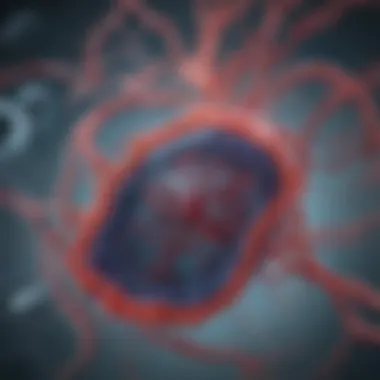Caspase 3: Key Role in Apoptosis and Homeostasis


Intro
Caspase 3, often referred to as an executioner caspase, plays a pivotal role in the process of apoptosis, a form of programmed cell death essential for maintaining cellular homeostasis. This enzyme is crucial not only for triggering apoptosis but also for regulating various cellular processes. Its activation leads to the dismantling of cellular structures and the eventual death of the cell, a process that is vital for the development and maintenance of healthy tissues.
Notably, the implications of caspase 3 extend beyond mere cell death. Research indicates that it participates actively in cell differentiation, proliferation, and even immune responses. This multifaceted role makes caspase 3 a significant focus in the study of both normal and diseased states, positioning it as a potential therapeutic target in various conditions such as cancer, neurodegenerative diseases, and autoimmune disorders.
In this article, we will explore the mechanisms through which caspase 3 operates, how it is regulated, and the therapeutic avenues it presents. By understanding its functions in apoptosis and cellular health, we can appreciate its relevance in broader biological contexts.
Preamble to Caspase
Caspase 3 is a crucial protease in the realm of cellular biology. Its roles extend beyond mere apoptosis, encompassing various functions that maintain cellular homeostasis. Understanding caspase 3 is essential, given its implications in both normal physiological processes and pathological conditions. This section introduces the significance of caspase 3, highlighting its definition, function, and historical context.
Definition and Function
Caspase 3, also known as executioner caspase, plays a pivotal role in initiating the process of apoptosis, which is a programmed cell death mechanism. The main function of caspase 3 is to cleave specific substrates leading to the morphological changes associated with apoptosis. This involve the disassembly of cellular components and ultimately results in cell death. Beyond apoptosis, caspase 3 is involved in various cellular mechanisms, including cell differentiation and proliferation. Its activation typically occurs through two major pathways: the intrinsic and extrinsic pathways, both of which are tightly regulated to ensure cellular integrity.
"Caspase 3 serves as a converging point for apoptotic signals, underscoring its integral role in maintaining cellular homeostasis."
Historical Context
Historically, the discovery of caspases dates back to the early 1990s when the foundational research on the apoptotic processes began to take shape. The identification of caspase 3 among the initial caspases was significant because it provided insights into the mechanisms controlling cell death. Researchers delved into the understanding of this enzyme, with studies showing that its dysfunction could lead to various diseases, including cancer and neurodegenerative disorders. The evolution of this research has profoundly impacted therapeutic approaches, emphasizing caspase 3's role as a target in drug development aimed at modulating cell death pathways. This historical perspective establishes a framework for exploring the deeper biochemical properties and implications of caspase 3 in disease paths that will be covered in the subsequent sections.
Biochemical Properties of Caspase
Understanding the biochemical properties of caspase 3 is crucial to grasp its role in apoptosis and cellular homeostasis. Caspase 3 is a cysteine protease that becomes activated during cellular stress or damage, leading to programmed cell death. This section reviews its structure and activation, as well as its enzymatic activity.
Structure and Activation
Caspase 3 is synthesized as an inactive proenzyme, also known as procaspase 3. Its primary structure includes a p20 and p10 subunit, which form a heterotetrameric structure when activated. Activation occurs through autocatalysis or by upstream initiator caspases in response to apoptotic signals.
The cleavage at specific aspartate residues of procaspase 3 is critically important. This irreversible transformation allows it to assume its active form, which enables the execution of apoptosis. Without this process, caspase 3 remains dormant, underscoring the significance of proper activation for cellular signaling.
Enzymatic Activity
Once activated, caspase 3 exhibits proteolytic activity that directly influences the apoptotic process. It cleaves various substrates within the cell, leading to the systematic dismantling of cellular components. Notably, its targets include structural proteins, DNA repair enzymes, and other caspases, which subsequently propagate the death signal.
The enzymatic activity of caspase 3 can be viewed in terms of its specificity for aspartic acid residues on substrate proteins. This selective process is essential for ensuring that only appropriate cellular targets are affected during apoptosis. This specificity also implies potential interactions with a variety of cellular signaling pathways, broadening its functional implications in health and disease.
Key Takeaway: The biochemical properties of caspase 3, from its structure and activation to its enzymatic functions, are foundational for its role in regulating apoptosis and maintaining cellular integrity.
Caspase in Apoptosis
Caspase 3 plays a critical role in the process of apoptosis, which is a programmed cell death mechanism vital for maintaining cellular homeostasis. Understanding the mechanisms through which caspase 3 functions provides insight into not only normal biological processes but also how dysregulation can lead to diseases. The significance of caspase 3 in apoptosis is multifactorial, involving its activation, regulation, and interactions with various cellular components.
Mechanisms of Apoptotic Pathways
Caspase 3 operates primarily within two apoptotic pathways: the intrinsic pathway and the extrinsic pathway. The intrinsic pathway is often triggered by cellular stress signals such as DNA damage or oxidative stress. In this pathway, signals lead to the release of cytochrome c from mitochondria, which subsequently activates apoptosome formation. This complex formation typically involves apaf-1 and procaspase 9, eventually leading to the activation of caspase 3.


On the other hand, the extrinsic pathway is initiated through the binding of death ligands to their respective receptors, often involving members of the tumor necrosis factor (TNF) family. The binding activates initiator caspases, most notably caspase 8, which then cleaves and activates caspase 3. Both pathways converge on caspase 3, underscoring its role as a crucial executioner of apoptosis.
"Caspase 3 acts as a central point of convergence for various apoptotic stimuli, thus highlighting its importance in the overarching cell death program."
In addition to these pathways, it’s essential to consider the post-translational modifications of caspase 3, such as phosphorylation or ubiquitination, which can influence its activity and stability. The intricate regulation through multiple layers showcases how apoptosis is tightly controlled.
Role in Cellular Homeostasis
Beyond its role in just initiating cell death, caspase 3 is integral to cellular homeostasis. It not only helps eliminate damaged or unwanted cells but also influences processes such as cellular differentiation, proliferation, and development. The controlled activation of caspase 3 can also facilitate the removal of cells that are no longer needed, allowing for tissue remodeling and regeneration.
Moreover, the activity of caspase 3 is not always antagonistic; it can positively regulate certain signaling pathways, aiding in maintaining normal cellular functions. For instance, in neural tissues, caspase 3 modulates pathways related to synaptic pruning, which is crucial for normal brain development.
In contrast, excessive or uncontrolled activation of caspase 3 can lead to unwanted cell death, which is associated with various pathologies, including neurodegenerative diseases and cancer. Therefore, maintaining a balance in caspase 3 activity is crucial for cellular health and effectiveness in organismal homeostasis.
In summary, caspase 3's dual role in both facilitating apoptosis and promoting cellular homeostasis highlights its importance in health and disease. Understanding these functions can provide vital avenues for therapeutic interventions.
Caspase in Disease Pathologies
Caspase 3 plays a significant role in various disease conditions, establishing its importance beyond the basic cellular functions of apoptosis. Its involvement in disease pathologies reveals how improper regulation or activity of this enzyme can contribute to disease progression or, conversely, protection against certain pathologies. Understanding these roles can provide insights into therapeutic strategies that modulate caspase 3 activity in different contexts of health and disease.
Cancer
Caspase 3 is often considered a double-edged sword in the context of cancer. On one hand, its activation leads to programmed cell death, which is essential for eliminating cancerous cells. On the other hand, cancer cells can develop resistance to apoptosis, often through mutations in apoptotic pathways including caspase 3.
Key points regarding caspase 3 in cancer include:
- Tumor Suppression: In healthy cells, caspase 3 acts as an effector caspase that executes apoptotic signals. Its activity is crucial in preventing cancerous cells from proliferating uncontrollably.
- Resistance Mechanisms: In many cancers, such as breast or colorectal cancer, the upregulation of inhibitors of apoptosis protein (IAP) such as survivin may inhibit the apoptotic pathway mediated by caspase 3. These adaptations can allow cancer cells to evade death.
- Therapeutic Strategies: Targeting caspase 3 through various therapeutic agents, including chemotherapeutics like doxorubicin, can enhance the apoptotic response in tumor cells.
"Understanding the regulation of caspase 3 in cancer could pave the way for innovative treatments that sensitize tumor cells to apoptosis."
Neurodegenerative Disorders
Neurodegenerative disorders, including Alzheimer's and Parkinson's diseases, demonstrate the critical role of caspase 3 in neuronal cell death. In these conditions, inappropriate activation of caspase 3 contributes to abnormal apoptosis that leads to significant neuronal loss.
Points of significance related to caspase 3 in neurodegenerative disorders are:
- Pathway Activation: In neurodegenerative diseases, factors such as oxidative stress or misfolded proteins can trigger the caspase cascade, leading to increased levels of caspase 3 activation. This results in the death of neurons and thus exacerbates the disease process.
- Biomarkers: Elevated levels of caspase 3 and its cleaved products have been identified as potential biomarkers for monitoring disease progression in conditions like Alzheimer's. This offers a way to assess cellular health in the central nervous system.
- Neuroprotective Approaches: Strategies aimed at inhibiting caspase 3 could be beneficial in these diseases. For instance, utilizing caspase-3 inhibitors has shown promise in preclinical models of neurodegeneration, which may lead to innovative treatments that slow disease progression.
In summary, caspase 3 is integral in the pathology of neurodegenerative conditions. Its regulation presents new opportunities for therapeutic interventions aimed at restoring cellular balance and preventing excessive neuronal loss.
Regulation of Caspase
The regulation of caspase 3 is a critical aspect of cellular biology and plays a significant role in maintaining cellular homeostasis. Understanding how caspase 3 is regulated provides insights into its function in apoptosis. This regulation is essential for several reasons. First, proper caspase 3 activity ensures that cells undergo programmed death appropriately, preventing the development of diseases such as cancer. Second, misregulation can lead to cellular dysfunction, which contributes to various pathological conditions. Therefore, studying the mechanisms that control caspase 3 is vital for developing therapeutic strategies targeting its dysregulation.
Inhibitory Mechanisms
Caspase 3 is tightly regulated by various inhibitory mechanisms to prevent unintended cellular apoptosis. These inhibitors work through multiple pathways. One of the foremost families of proteins involved in caspase inhibition is the inhibitor of apoptosis proteins (IAPs). IAPs bind to active caspases, preventing their function. This inhibition is crucial for maintaining a balance between cell survival and death.


Another important player is the Bcl-2 family of proteins, which regulates apoptosis at the mitochondrial level. Anti-apoptotic members, such as Bcl-2 and Bcl-xL, hinder the activation of caspases by preventing mitochondrial outer membrane permeabilization.
Additionally, post-translational modifications also serve as regulatory mechanisms. For example, caspase 3 can be modified through phosphorylation or ubiquitination to alter its activity or stability. The intricate balance of these inhibitory signals ensures that apoptosis is executed only under appropriate cellular contexts, emphasizing the complexity of caspase regulation.
Gene Expression Regulation
Gene expression regulation plays a fundamental role in modulating caspase 3 levels within cells. The transcription of the caspase 3 gene is controlled by various factors, including transcription factors and signaling pathways. p53, a well-known tumor suppressor protein, can upregulate caspase 3 in response to cellular stress, facilitating apoptosis. Conversely, under conditions favoring cell survival, such as in cancer cells, other signaling molecules may downregulate caspase 3 expression, allowing for uncontrolled cell proliferation.
Moreover, epigenetic modifications also impact the regulation of caspase 3. Changes in methylation and histone modification can silence or activate the gene, thus influencing the amount of caspase 3 produced within the cell. Such nuances in gene expression highlight the multifaceted control mechanisms in place governing caspase 3 and, consequently, apoptosis.
It is essential to comprehend both the inhibitory mechanisms and the regulatory effects on gene expression, as they interlink to form a comprehensive picture of how caspase 3 activity is finely tuned in normal and pathological conditions.
Caspase and Therapeutic Applications
Caspase 3 plays a critical role in both apoptosis and cellular homeostasis, making it an attractive target for therapeutic applications. Understanding the functions and implications of caspase 3 is essential, particularly in the context of disease treatment strategies. This section will explore how targeting caspase 3 can contribute to cancer therapy and neuroprotection strategies.
Targeting Caspase in Cancer Therapy
In cancer, the regulation of cell death is often disrupted. Tumor cells frequently acquire resistance to apoptosis, allowing them to survive longer than normal cells. By targeting caspase 3, researchers aim to restore the apoptotic pathways that are frequently impaired in cancerous cells. This restoration can lead to the selective death of cancer cells while sparing healthy tissues.
Targeting caspase 3 can occur through various approaches:
- Caspase Activators: These agents are designed to artificially activate caspase 3 in tumor cells, promoting apoptosis.
- Inhibitors of Anti-apoptotic Proteins: Compounds that inhibit proteins such as Bcl-2 can lead to an increase in caspase 3 activity.
- Combination Therapies: Using caspase 3 targeting in conjunction with traditional treatments like chemotherapy can enhance the overall effectiveness, improving patient outcomes.
Despite the potential, there are significant considerations. The balance between promoting apoptosis in cancer cells and avoiding unwanted cell death in normal tissues is delicate. Careful design and testing of these therapies are crucial to achieving this balance.
Neuroprotection Strategies
Caspase 3 is also implicated in neurodegenerative disorders where inappropriate activation can lead to neuron loss. Strategies that inhibit caspase 3 activity might offer protective benefits in conditions such as Alzheimer’s disease and Parkinson’s disease.
Some neuroprotection strategies include:
- Caspase Inhibitors: These compounds may prevent cell death in neurons, providing a window for recovery and repair, especially in early neurodegenerative processes.
- Pharmacological Agents: Drugs that modulate signaling pathways leading to caspase 3 activation can help delay the progression of neurological diseases.
- Gene Therapy Approaches: Targeting the expression of genes that regulate caspase 3 may provide long-term benefits in maintaining neuronal viability.
"Caspase 3 functions as the executioner of apoptosis, but its role in diseases opens a realm of therapeutic strategies that seek to modify its activity."
In summary, the therapeutic applications of targeting caspase 3 present significant opportunities for advancing treatment in cancer and neurodegenerative conditions. While the approach offers promising results, the intricacies of caspase 3's function necessitate rigorous research and precision to maximize therapeutic potential.
Experimental Models for Caspase Study
Understanding the functions of caspase 3 necessitates reliable experimental models. These models are essential because they provide insights into the role of caspase 3 in apoptosis and cellular homeostasis. Each model has its strengths and weaknesses, allowing researchers to explore specific aspects of caspase biology under controlled conditions. The choice between in vitro and in vivo approaches significantly impacts the depth of findings.
In Vitro Approaches
In vitro methods involve studying caspase 3 in controlled laboratory environments. Cell lines such as HeLa, Jurkat, and primary cells from various tissues are commonly used. One of the main benefits of in vitro approaches is the ease of manipulating conditions to observe specific pathways relevant to caspase 3 activity.
Key aspects of in vitro studies include:


- Controlled Environment: Researchers can precisely manage factors like nutrient levels and pH.
- Reproducibility: Experiments can be repeated under identical conditions to validate results.
- High-throughput Screening: Large-scale studies can be conducted to identify potential modulators of caspase 3.
However, these approaches also have limitations. The cellular environment in vitro may not accurately mimic the complexities of living organisms. For instance, signaling pathways that affect caspase 3 could be altered. Hence, findings need to be corroborated by in vivo studies.
In Vivo Models
In vivo models provide a holistic view of caspase 3 functions within the context of an entire organism. Animal models, such as mice genetically modified to express or repress caspase 3, allow researchers to observe physiological responses in real time.
Advantages of in vivo studies include:
- Complex Interactions: They account for interactions between different cell types and whole-body systems, mimicking actual physiological conditions.
- Translational Relevance: Data from these models can be more directly applicable to human health and disease.
- Longitudinal Studies: Researchers can study the progression of diseases where caspase 3 is a key player over time.
However, in vivo models are resource-intensive and involve ethical considerations. The complexity of living organisms can introduce variability that may complicate data interpretation.
In summary, both in vitro and in vivo models play crucial roles in advancing our understanding of caspase 3. They provide complementary insights, enabling researchers to uncover mechanisms of action and potential therapeutic targets.
Future Perspectives
Caspase 3 plays a pivotal role in cellular processes, including apoptosis and cellular homeostasis. Understanding the future direction of research on caspase 3 is crucial for advancing therapeutic interventions in numerous diseases. As scientists continue to unveil the complex mechanisms surrounding caspase 3, several key elements stand out for future exploration.
First, emerging technologies in molecular biology and biochemistry offer new avenues to study caspase 3. Techniques such as CRISPR-Cas9 gene editing and high-throughput screening could provide deeper insights into the specific pathways that regulate caspase 3 activation. These innovations can allow researchers to manipulate caspase activity in controlled environments, facilitating the identification of novel inhibitors or activators that could be pivotal in treating diseases associated with dysregulated apoptosis.
Second, there is a heightened interest in the role of caspase 3 in different diseases beyond cancer and neurodegenerative disorders. Recent studies hint that caspase 3 might be involved in various metabolic diseases, cardiovascular conditions, and even infectious diseases. Future investigations could elucidate how the modulation of caspase 3 affects these conditions, aiding in developing tailored therapeutic strategies.
Lastly, the benefits of understanding caspase 3 extend beyond healthcare. Insights into its functioning can influence fields such as developmental biology and regenerative medicine. For instance, understanding how caspase 3 regulates cell turnover and its involvement in tissue repair can advance regenerative strategies, leading to innovative treatments for injuries and degenerative diseases.
"The exploration of caspase 3's multifaceted role could transform therapeutic approaches across numerous health domains."
Emerging Research Areas
Emerging research areas related to caspase 3 are expanding rapidly. Several topics are particularly significant for further exploration.
- Caspase 3 in Immunology: The interplay between apoptosis and immune responses is gaining interest. Understanding how caspase 3 influences immune cell death and function could lead to breakthroughs in autoimmune and inflammatory diseases.
- Caspase 3 and Aging: The role of caspase 3 in cellular senescence and aging processes is under investigation. Deciphering its role may yield insights into age-related diseases and longevity.
- Caspase 3 in Cardiovascular Health: Recent studies suggest caspase 3 may influence cardiac cell survival. Exploring this connection may provide new strategies for managing heart diseases.
Innovative Therapeutic Strategies
The quest for innovative therapeutic strategies centered around caspase 3 is vital for developing effective treatments.
- Targeting Caspase 3 Modulators: Identifying small molecules that can specifically inhibit or activate caspase 3 could serve as powerful therapeutic agents. Such compounds might be used in various conditions, such as cancer or neurodegenerative diseases.
- Gene Therapy Approaches: Utilizing gene therapy to modulate the expression levels of caspase 3 may offer a way to restore normal apoptosis in cells that have malfunctioned.
- Combination Therapies: Exploring combination therapies that include caspase 3 modulation alongside other treatment modalities may enhance therapeutic effectiveness. Combinations could target multiple pathways involved in disease progression.
In sum, the potential for future advancements surrounding caspase 3 is significant. By focusing on emerging research areas and innovative therapies, scientists can pave the way for new treatments that harness the unique roles of this critical enzyme in health and disease.
End
The conclusion of this article underscores the pivotal role of caspase 3 in the realms of apoptosis and cellular homeostasis. Understanding caspase 3 is not merely an academic pursuit; it has profound implications in various biological contexts. Its function as a cysteine protease positions caspase 3 as a key player in regulating programmed cell death, a fundamental process crucial to maintaining cellular health. Moreover, the dysregulation of this enzyme has been associated with numerous diseases, such as cancer and neurodegenerative disorders.
Summary of Key Points
Throughout the discussion, several critical points have emerged:
- Caspase 3 functions as a central mediator of apoptosis, facilitating the execution phase of cell death through its enzymatic activity.
- Its structural features and activation mechanisms are essential for proper functioning, underscoring the biochemical nuances that govern its role.
- Caspase 3 is intricately involved in cellular homeostasis, impacting balance within physiological processes.
- Understanding its regulatory mechanisms, including inhibitory pathways and gene expression, can offer insights into therapeutic targets for disease management.
- Experimental models studying caspase 3 have proven invaluable in elucidating its role in various contexts, contributing to the body of research that informs modern therapies.
Final Thoughts on Caspase
Caspase 3's significance extends beyond simple biochemical reactions; it represents a crucial pivot point in cellular biology. The ability to manipulate or influence its pathways holds promise for therapeutic strategies in treating diseases linked with apoptosis dysfunction. As research progresses, the nuanced understanding of caspase 3 will likely open doors to innovative treatments and interventions, marking it as one of the critical focal points in biomedical research moving forward. In summary, continued exploration of caspase 3 not only enriches our understanding of cellular mechanics but also paves the way for potential advancements in medical science and treatment approaches.







